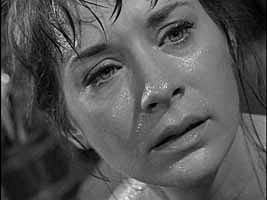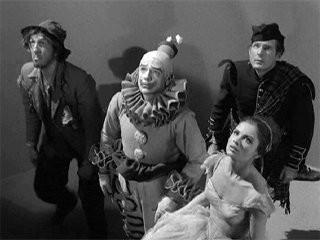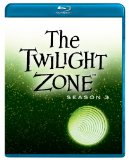| Reviews & Columns |
|
Reviews DVD TV on DVD Blu-ray 4K UHD International DVDs In Theaters Reviews by Studio Video Games Features Collector Series DVDs Easter Egg Database Interviews DVD Talk Radio Feature Articles Columns Anime Talk DVD Savant Horror DVDs The M.O.D. Squad Art House HD Talk Silent DVD
|
DVD Talk Forum |
|
|
| Resources |
|
DVD Price Search Customer Service #'s RCE Info Links |
|
Columns
|
|
|
Twilight Zone - Season 3, The
In all, Season 3 offers some of Twilight Zone's all-time best episodes along with several of the absolute worst. The season's most famous shows, notably "It's a Good Life" and "To Serve Man," overshadow under-appreciated episodes as good or better, and a few unjustly-maligned or dismissed episodes are also ripe for rediscovery.
As with The Twilight Zone - Season One and Season Two, the considerable bump in picture quality justifies the cost of upgrading these shows from their already fine DVD versions. Indeed, high-def enables the viewer to appreciate the wonderfully atmospheric photography of several heretofore underrated episodes whose now inky blacks had for years been dull dark gray in their 16mm syndication prints. The mountain of older extra features has been ported over, supplemented with more audio commentaries, radio dramas and, best of all, isolated scores for all 37 shows, even those consisting entirely of library music.
"The Midnight Sun"
Season Three's Top Ten
1. "Little Girl Lost" by Richard Matheson - Season three's best episode taps into every parent's worst nightmare: a child is just out of reach, out of sight and crying for help, and despite their best and most frantic efforts, the mother and father can do nothing. This episode compounds the anxiety in that the girl goes missing in her own bedroom: she's fallen through a wall into another dimension. Actor-turned-director Paul Stewart (Citizen Kane) gets appropriately tense performances out of his three lead actors (Robert Sampson and Sarah Marshall as the parents, Charles Aidman wonderful as their physicist neighbor) and Bernard Herrmann's eerie score adds to the tension.
2. "Five Characters in Search of an Exit" by Rod Serling, adapting Marvin Petal's "The Depository" - One of the great What-the-Hell-is-Going-on-Here?!" shows. An army major (William Windom) finds himself trapped in a featureless cylindrical room along with a circus clown (Murray Matheson), a ballerina (Susan Harrison), a tramp (Kelton Garwood), and a bagpiper (Clark Allen). Where are they? Proof that sometimes less is more.
3. "The Midnight Sun" by Rod Serling - Lois Nettleton's marvelous performance bolsters this excellent episode about a strong-willed woman, an artist living in (apparently) Manhattan, coming to grips with the end of world as the earth is slowly being pulled toward the sun. The series' trademark twist endings, which eventually became rather obligatory, much to the show's detriment, is unusually effective and unnerving here.
4. "It's a Good Life" by Rod Serling, adapting Jerome Bixby's story - The one that everyone remembers, and with good reason. Little Anthony Fremont (seven-year-old Billy Mumy) is a monstrous child with God-like powers, terrorizing what's left of the universe, a small Ohio town where its adult population lives in constant fear of being "wished into the cornfield." The superb ensemble cast of character actors - John Larch, Cloris Leachman, Don Keefer, Max Showalter/Casey Adams, et. al. - really sell the terror.
5. "Hocus-Pocus and Frisby" by Rod Serling, adapting Frederic Louis Fox's story - Serling frequently attempted whimsical or broadly comic episodes, but most of these are painfully unamusing (see below). This episode, with roly-poly, raspy-voiced Andy Devine as an inveterate liar, spinning wild yarns about his supposed accomplishments, is a real charmer, and its narrative has the flavor of something out of the pages of EC Comics.
6. "The Arrival" by Rod Serling - Not a particularly popular show, probably because this drama's conflict is entirely internalized, the guilt felt of an FAA investigator (well-played by Harold J. Stone) looking into the mysterious arrival of a flight from Buffalo, New York - a routine flight that lands safely on the tarmac but, unaccountably, the plane is minus its passengers and crew. This unusual episode grapples with themes rarely attempted in movies and TV (Atom Egoyan's 1997 film The Sweet Hereafter being another example), of the tortuous impact of unexplainable, random tragedy.
7. "I Sing the Body Electric" by Ray Bradbury - The great writer's only produced Twilight Zone script was considered a huge disappointment and Bradbury himself held a grudge against Serling for many years after. The episode doesn't quite live up to its full potential, but its story of a lonely girl (Veronica Cartwright), unable to move forward after the death of her mother and hostile toward the robot grandmother (Josephine Hutchinson) her father has hired to raise his three children, is unexpectedly moving and effective.
8. "The Shelter" by Rod Serling - Though an obvious attempt by Serling to replicate the success of Season One's "The Monsters Are Due on Maple Street," this story of friendly neighbors suddenly clawing at each other to get into their street's only fallout shelter was timely as hell - that summer President Kennedy had advised all Americans to build them in anticipation of a possible nuclear attack - yet Serling's pessimistic teleplay grimly opines that life on either side of the shelter door isn't worth living. Oddly, the Blu-ray's liner notes suggest the threat of alien invaders, not an imminent Soviet strike.
9. "To Serve Man" by Rod Serling, adapting Damon Knight's story - Though gimmicky, a bit undernourished production-wise, and not particularly well-directed by Richard L. Bare (who'd soon go on to direct almost every episode of Green Acres), this episode's twist ending long ago became part of the pop culture lexicon; star Lloyd Bochner even spoofed his character in one of the Naked Gun movies. Nine-feet-tall humanoids from outer space (all played by Richard Kiel, though voiced by Joseph Ruskin, "The Man in the Bottle") land on earth with a simple goal: to serve man. They eradicate hunger, cure disease, end war...but there's a catch.*
10. "Kick the Can" by George Clayton Johnson - After Steven Spielberg's shameless and syrupy remake for the 1983 Twilight Zone feature, this understated episode directed by the late Lamont Johnson gets better and better, especially Ernest Truex's sincere, subtle leading performance.
Most Underrated
1. "The Arrival" by Rod Serling - (see above)
2. "I Sing the Body Electric" by Ray Bradbury - (see above)
3. "The Hunt" by Earl Hamner, Jr. - The creator of The Waltons contributed several good scripts to Twilight Zone, most with backwoods settings like this one, though not exclusively so (Season Five's "Ring-a-Ding Girl" and "You Drive" being interesting exceptions). This tale of an old-timer (veteran character player Arthur Hunnicutt) going to Kuntry Heaven is better than it sounds, ultimately sweet and clever.
4. "The Little People" by Rod Serling - Though as old a sci-fi chestnut as they come, and despite a hammy if committed performance by Joe Maross, there's something beguiling about this two-man story about astronauts (the other played by Claude Akins) stranded on a desert planet populated by humanoids tinier than ants, beings that soon give Maross's character delusions of grandeur.
5. "The Passersby" by Rod Serling - Despite an unnecessary cameo by Abraham Lincoln at the end, this story of a Confederate War widow unwilling to acknowledge her own death is well acted by its leads (Joanne Linville and James Gregory) with the kind of internalized conflict that had been the heart of seasons one and two but which were increasingly giving way to more gimmicky set-ups and plot twists like "To Serve Man."
Most Overrated
1. "A Game of Pool" by George Clayton Johnson - or: The Hustler, with a ghost. Small-time pool shark Jesse Cardiff (Jack Klugman) stakes his life against legendary - and long-deceased - ace "Fats" Brown (Jonathan Winters). Johnson himself later admitted to being heavily influenced by The Hustler (the novel, not the film, which was produced and released almost simultaneously), but what's worse is that the story as filmed simply doesn't make sense. Why must Jesse risk his life? Why is he later obliged to defend his title in "billiards purgatory," etc. Serling made things worse changing Johnson's ending while he was out of town making a movie.
2. "To Serve Man" by Rod Serling, adapting Damon Knight's story - (see above)
3. "The Trade-Ins" and "The Changing of the Guard," each by Rod Serling - Well-regarded but hopelessly sentimental (in the bad sense) tales of cute old folk: Pathetic Joseph Schildkraut in the former, whiny Donald Pleasance in the latter, both wearing obvious make-up to make them look older than they were (Schildkraut was in his sixties, Pleasance in his early-forties). The script for "The Trade-Ins" isn't bad; it's Schildkraut's indulgent performance that dooms it, while "Changing of the Guard," like "A Game of Pool" all too obviously draws on another source, in this case Goodbye, Mr. Chips. With ghosts.
Twilight Turkeys
Season Three has more than its share of weak episodes: "One More Pallbearer," "Showdown with Rance McGrew," "Four O'Clock." But these next two are strong contenders as Twilight Zone's all-time turkeys:
1. "Cavender Is Coming" by Rod Serling - This was Serling's second (at least) attempt to create a new series around a bumbling mortal and/or his/her guardian angel. Season one's stab at the same material, "Mr. Bevis," wasn't very good, but that plays like Masterpiece Theater compared to this atrocious and visually tacky effort, ironically Twilight Zone's single most expensive half-hour show. Agnes Grep (Carol Burnett) gets a leg up from guardian angel Cavender (Jesse White). With or without a laugh track (viewers have both options), there's not a single laugh to be had.
2. "The Mirror" by Rod Serling - A miscast Peter Falk is hammy and unconvincing (more so in high-def, given Falk's obviously fake beard) as Ramos Clemente, a thinly disguised Fidel Castro, whose army overthrew the Cuban government just two years earlier. Serling's preachy script about absolute power corrupting absolutely is absolutely corrupted with Cold War polemics.
Four of the "Five Characters in Search of an Exit"
Video & Audio
As with Seasons 1 & 2, The Twilight Zone - Season 3 looks just great in high-definition, pillar-boxed to 1.37:1, showing incredibly little wear for such a perennially-printed, 50-year-old show. A few shows like the Lewton-esque "The Grave" and "The Jungle," with their dark moody lighting, benefit especially. The inky blacks and added high-def detail really make these play almost like new theatrical features; the black and white photography is just sensational.
The uncompressed PCM mono audio is likewise strong, though I personally find the "restored audio" option has the music track mixed too low and the dialogue track too high, and I've stuck with the perfectly fine original mono, also included. The five discs are region "A" encoded. Menu screens are easy to navigate. Optional English SDH subtitles are included.
Extra Features
Supplements are more modest this time out, limited mainly to new audio commentaries, isolated music scores for every episode, and 19 radio adaptations featuring the likes of Jason Alexander, Adam West, Michael York, and others. Beyond that a video interview with Edson Stroll ("The Trade-Ins") and an audio-only one with DP George T. Clemens are included, and a laugh track or no laugh-track option on "Cavender is Coming."
There are fewer audio commentaries, and I think unwisely some of these are doubled-up, sometimes with previously released material: two each on "A Game of Pool," "The Grave," "It's a Good Life," "The Midnight Sun," "The Jungle," while a few commentary-worthy episodes go without. All the previously released material is represented here, and the sponsor spots, and Serling-hosted previews of next week's shows are also in high-def.
Parting Thoughts
Though uneven, The Twilight Zone - Season 3 offers some of the series' finest half-hours as well as a big handful of underrated episodes worth rediscovery. A DVD Talk Collector Series title.
This review is dedicated to William Windom, James Best, and Richard Matheson.
* Sergei Hasenecz writes, "I'm not going to argue with the cultural impact of this episode, and I understand why the episode 'works' and is a favorite for so many people, but it also gets my vote as the most stupid. Hungry aliens travel millions of light-years to Earth to harvest skinny humans for food. Why the hell didn't they take all the cattle instead? Not only is there much more meat on cattle, they reproduce faster and are more easily sustainable as a reliable source for food. But then aliens tend to be idiotic in their designs upon Earth. (See ... Signs for aliens of record-setting stupidity.)"
Stuart Galbraith IV's latest audio commentary, for AnimEigo's Musashi Miyamoto DVD boxed set, is on sale now.
|
| Popular Reviews |
| Sponsored Links |
|
|
| Sponsored Links |
|
|
| Release List | Reviews | Shop | Newsletter | Forum | DVD Giveaways | Blu-Ray | Advertise |
|
Copyright 2024 DVDTalk.com All Rights Reserved. Legal Info, Privacy Policy, Terms of Use,
Manage Preferences,
Your Privacy Choices | |||||||














